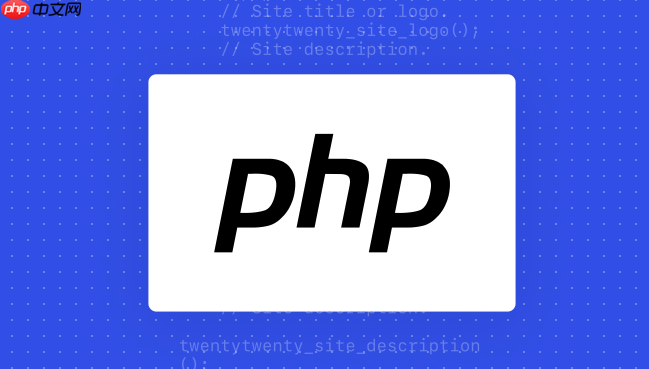 Backend Development
Backend Development
 PHP Tutorial
PHP Tutorial
 How to use PHP to develop product recommendation module PHP recommendation algorithm and user behavior analysis
How to use PHP to develop product recommendation module PHP recommendation algorithm and user behavior analysis
How to use PHP to develop product recommendation module PHP recommendation algorithm and user behavior analysis
Jul 23, 2025 pm 07:00 PMTo collect user behavior data, you need to record browsing, search, purchase and other information into the database through PHP, and clean and analyze it to explore interest preferences; 2. The selection of recommendation algorithms should be determined based on data characteristics: based on content, collaborative filtering, rules or mixed recommendations; 3. Collaborative filtering can be implemented in PHP to calculate user cosine similarity, select K nearest neighbors, weighted prediction scores and recommend high-scoring products; 4. Performance evaluation uses accuracy, recall, F1 value and CTR, conversion rate and verify the effect through A/B tests; 5. Cold start problems can be alleviated through product attributes, user registration information, popular recommendations and expert evaluations; 6. Performance optimization methods include cached recommendation results, asynchronous processing, distributed computing and SQL query optimization, thereby improving recommendation efficiency and user experience.

The core of PHP's product recommendation module is to combine user behavior data and recommendation algorithms to provide users with personalized product recommendations, thereby improving users' shopping experience and sales conversion rate.

To develop product recommendation modules using PHP, you need to have an in-depth understanding of user behavior analysis and select appropriate recommendation algorithms. Here are some details on how to achieve this goal.
How to collect and analyze user behavior data?
User behavior data is the basis of recommendation algorithms. We need to collect various behaviors of users on the website, such as browsing history, search for keywords, purchase history, adding to shopping carts, reviews, etc. This data can be recorded in the database through PHP code.

After the data is collected, cleaning and analysis are required. Cleaning includes removing duplicate data, processing missing values, converting data formats, etc. Analysis can use SQL queries, PHP scripts or more advanced data analysis tools (such as Python's Pandas library, which can call Python scripts through PHP's exec() function).
The purpose of analysis is to understand the user's interest preferences. For example, you can count the product categories that users browse the most, buy the most, search the most, and so on. You can also use association rule mining algorithms (such as the Apriori algorithm) to discover the correlation between products. For example, users who purchase product A often purchase product B.

Here is a simple PHP code example that records the behavior of users browsing products:
<?php
// Assume that the user ID and product ID have already obtained $user_id = $_SESSION['user_id'];
$product_id = $_GET['product_id'];
// Connect to the database $conn = new mysqli("localhost", "username", "password", "database");
// Check if the connection is successful if ($conn->connect_error) {
die("Connection failed: " . $conn->connect_error);
}
// Insert browsing history $sql = "INSERT INTO user_browsing_history (user_id, product_id, timestamp) VALUES ($user_id, $product_id, NOW())";
if ($conn->query($sql) === TRUE) {
echo "Browsing history saved";
} else {
echo "Error: " . $sql . "<br>" . $conn->error;
}
$conn->close();
?>How to choose the right recommendation algorithm?
Common recommended algorithms include:
- Content-based recommendation: Recommend products similar to those that users like in the past based on the product attributes (such as categories, brands, descriptions, etc.) and the user's historical behavior.
- Collaborative filtering recommendation: Recommend products that users may like based on the similarity between users or similarity between products. Collaborative filtering is divided into user-based collaborative filtering and product-based collaborative filtering.
- Rule-based recommendation: Recommend products that meet specific conditions based on predefined rules. For example, if the user purchases product A, product B is recommended.
- Mixed recommendation: Combining the advantages of multiple recommendation algorithms, improve the accuracy and diversity of recommendations.
Which recommendation algorithm to choose depends on the characteristics of the data and business needs. If the product attribute information is relatively complete, you can consider content-based recommendations. If the number of users and products are relatively large, you can consider collaborative filtering of recommendations. If there are some clear business rules, rule-based recommendations can be considered.
Implementing these algorithms in PHP, you can write your own code or use the ready-made recommended algorithm library. For example, similarity calculations can be implemented using PHP's mathematical function library, or an open source recommended algorithm library (if present).
How to implement collaborative filtering recommendations in PHP?
Taking user-based collaborative filtering as an example, we introduce how to implement recommendations in PHP:
Calculate the similarity between users: methods such as cosine similarity, Pearson correlation coefficient, etc. can be used. For example, the cosine similarity can be calculated by the following formula:
similarity(userA, userB) = cos(θ) = (userA · userB) / (||userA|| * ||userB||)
Among them,
userAanduserBare the scoring vectors of user A and user B,·the dot product of the vector, and|| ||represents the modulus of the vector.Find users who are similar to the target user: Select the K users with the highest similarity as neighbor users.
Based on the ratings of neighbor users, predict the target user's ratings for unrated items: a weighted average method can be used. For example, the predicted score of product i by user A can be calculated by the following formula:
predicted_rating(userA, itemI) = ∑(similarity(userA, userN) * rating(userN, itemI)) / ∑similarity(userA, userN)
Among them,
userNis the neighbor user of user A,rating(userN, itemI)is the rating of user N on product i.Recommended products with the highest prediction score: Select N products with the highest prediction score as the recommendation result.
Here is a simplified PHP code example for calculating cosine similarity between users:
<?php
// Assume that the user rating data has been read from the database into the array $ratings// $ratings is a two-dimensional array, where $ratings[$user_id][$product_id] represents the user $user_id's rating function cosine_similarity($user1, $user2, $ratings) {
$dot_product = 0;
$norm1 = 0;
$norm2 = 0;
foreach ($ratings[$user1] as $product => $rating1) {
if (isset($ratings[$user2][$product])) {
$rating2 = $ratings[$user2][$product];
$dot_product = $rating1 * $rating2;
}
$norm1 = pow($rating1, 2);
}
foreach ($ratings[$user2] as $product => $rating2) {
$norm2 = pow($rating2, 2);
}
if ($norm1 == 0 || $norm2 == 0) {
return 0;
}
return $dot_product / (sqrt($norm1) * sqrt($norm2));
}
// Example: Calculate the similarity between user 1 and user 2 $similarity = cosine_similarity(1, 2, $ratings);
echo "Similarity between User 1 and User 2: " . $similarity;
?>How to evaluate the performance of recommended modules?
Evaluating the performance of the recommendation module is very important, which can help us understand the effectiveness of the recommendation algorithm and optimize it. Common evaluation metrics include:
- Accuracy: The ratio of recommended products that users really like.
- Recall: The ratio of recommended products that users really like.
- F1 value: the harmonic average of accuracy and recall.
- Click-through Rate (CTR): The ratio of recommended products clicked by users.
- Conversion Rate: The ratio of recommended products purchased by users.
You can use the A/B testing method to compare the effects of different recommended algorithms. Divide the user into two groups, one uses the old recommendation algorithm and the other uses the new recommendation algorithm, and then compare the click-through rate, conversion rate and other indicators of the two groups of users to determine whether the new recommendation algorithm is more effective.
How to solve the cold start problem?
The cold start problem refers to the difficulty in recommending new users or new products due to lack of historical data. Common solutions include:
- Utilize product attributes: For new products, they can be recommended to users who like similar products based on their attributes (such as category, brand, description, etc.).
- Utilize user registration information: For new users, products related to their interests can be recommended based on their registration information (such as age, gender, interests, etc.).
- Popular recommendations: Recommend the most popular products, which can attract new users and collect their behavioral data.
- Expert recommendation: Invite experts or users to evaluate new products and use the evaluation results as the basis for recommendation.
How to optimize the performance of recommended modules?
The performance of the recommended module directly affects the user experience. The performance of the recommended module can be optimized by the following methods:
- Use Cache: Cache commonly used recommended results to avoid repeated calculations.
- Use asynchronous processing: put time-consuming recommended calculations in the background to avoid blocking user requests.
- Using a distributed system: distribute recommended computing to multiple servers to improve computing power.
- Optimize database query: Optimize SQL query statements to improve data reading speed.
In short, developing product recommendation modules for PHP is a complex process that requires in-depth understanding of user behavior analysis and recommendation algorithms, and continuous optimization and improvement.
The above is the detailed content of How to use PHP to develop product recommendation module PHP recommendation algorithm and user behavior analysis. For more information, please follow other related articles on the PHP Chinese website!

Hot AI Tools

Undress AI Tool
Undress images for free

Undresser.AI Undress
AI-powered app for creating realistic nude photos

AI Clothes Remover
Online AI tool for removing clothes from photos.

Clothoff.io
AI clothes remover

Video Face Swap
Swap faces in any video effortlessly with our completely free AI face swap tool!

Hot Article

Hot Tools

Notepad++7.3.1
Easy-to-use and free code editor

SublimeText3 Chinese version
Chinese version, very easy to use

Zend Studio 13.0.1
Powerful PHP integrated development environment

Dreamweaver CS6
Visual web development tools

SublimeText3 Mac version
God-level code editing software (SublimeText3)
 How to download the Binance official app Binance Exchange app download link to get
Aug 04, 2025 pm 11:21 PM
How to download the Binance official app Binance Exchange app download link to get
Aug 04, 2025 pm 11:21 PM
As the internationally leading blockchain digital asset trading platform, Binance provides users with a safe and convenient trading experience. Its official app integrates multiple core functions such as market viewing, asset management, currency trading and fiat currency trading.
 How to create a virtual environment in Python
Aug 05, 2025 pm 01:05 PM
How to create a virtual environment in Python
Aug 05, 2025 pm 01:05 PM
To create a Python virtual environment, you can use the venv module. The steps are: 1. Enter the project directory to execute the python-mvenvenv environment to create the environment; 2. Use sourceenv/bin/activate to Mac/Linux and env\Scripts\activate to Windows; 3. Use the pipinstall installation package, pipfreeze>requirements.txt to export dependencies; 4. Be careful to avoid submitting the virtual environment to Git, and confirm that it is in the correct environment during installation. Virtual environments can isolate project dependencies to prevent conflicts, especially suitable for multi-project development, and editors such as PyCharm or VSCode are also
 Ouyi Exchange APP Android version v6.132.0 Ouyi APP official website download and installation guide 2025
Aug 04, 2025 pm 11:18 PM
Ouyi Exchange APP Android version v6.132.0 Ouyi APP official website download and installation guide 2025
Aug 04, 2025 pm 11:18 PM
OKX is a world-renowned comprehensive digital asset service platform, providing users with diversified products and services including spot, contracts, options, etc. With its smooth operation experience and powerful function integration, its official APP has become a common tool for many digital asset users.
 Binance official app download latest link Binance exchange app installation portal
Aug 04, 2025 pm 11:24 PM
Binance official app download latest link Binance exchange app installation portal
Aug 04, 2025 pm 11:24 PM
Binance is a world-renowned digital asset trading platform, providing users with secure, stable and rich cryptocurrency trading services. Its app is simple to design and powerful, supporting a variety of transaction types and asset management tools.
 Binance official app latest official website entrance Binance exchange app download address
Aug 04, 2025 pm 11:27 PM
Binance official app latest official website entrance Binance exchange app download address
Aug 04, 2025 pm 11:27 PM
Binance is one of the world's well-known digital asset trading platforms, providing users with safe, stable and convenient cryptocurrency trading services. Through the Binance App, you can view market conditions, buy, sell and asset management anytime, anywhere.
 Best Practices for Managing Large MySQL Tables
Aug 05, 2025 am 03:55 AM
Best Practices for Managing Large MySQL Tables
Aug 05, 2025 am 03:55 AM
When dealing with large tables, MySQL performance and maintainability face challenges, and it is necessary to start from structural design, index optimization, table sub-table strategy, etc. 1. Reasonably design primary keys and indexes: It is recommended to use self-increment integers as primary keys to reduce page splits; use overlay indexes to improve query efficiency; regularly analyze slow query logs and delete invalid indexes. 2. Rational use of partition tables: partition according to time range and other strategies to improve query and maintenance efficiency, but attention should be paid to partitioning and cutting issues. 3. Consider reading and writing separation and library separation: Read and writing separation alleviates the pressure on the main library. The library separation and table separation are suitable for scenarios with a large amount of data. It is recommended to use middleware and evaluate transaction and cross-store query problems. Early planning and continuous optimization are the key.
 What is the difference between TRUNCATE, DELETE, and DROP in MySQL?
Aug 05, 2025 am 09:39 AM
What is the difference between TRUNCATE, DELETE, and DROP in MySQL?
Aug 05, 2025 am 09:39 AM
DELETEremovesspecificorallrows,keepstablestructure,allowsrollbackandtriggers,anddoesnotresetauto-increment;2.TRUNCATEquicklyremovesallrows,resetsauto-increment,cannotberolledbackinmostcases,doesnotfiretriggers,andkeepstablestructure;3.DROPremovesthee
 go by example running a subprocess
Aug 06, 2025 am 09:05 AM
go by example running a subprocess
Aug 06, 2025 am 09:05 AM
Run the child process using the os/exec package, create the command through exec.Command but not execute it immediately; 2. Run the command with .Output() and catch stdout. If the exit code is non-zero, return exec.ExitError; 3. Use .Start() to start the process without blocking, combine with .StdoutPipe() to stream output in real time; 4. Enter data into the process through .StdinPipe(), and after writing, you need to close the pipeline and call .Wait() to wait for the end; 5. Exec.ExitError must be processed to get the exit code and stderr of the failed command to avoid zombie processes.





